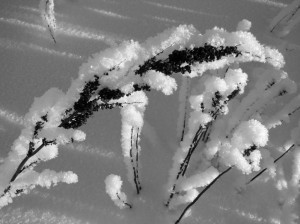 As we start to thrill at the first cool fall evening, weekend of bonfire wiener roasts, and the colorful display of Midwestern deciduous trees, there is also work to be done. Our last few tomatoes might be taking longer to turn from green to red as the temperature cools and our other plants might be starting to spot or turn brown.
As we start to thrill at the first cool fall evening, weekend of bonfire wiener roasts, and the colorful display of Midwestern deciduous trees, there is also work to be done. Our last few tomatoes might be taking longer to turn from green to red as the temperature cools and our other plants might be starting to spot or turn brown.
After the harvest is clean-up time—not so much to make it look nice while under snow cover, but to keep disease from harboring in the garden and to get the garden bed ready for spring. It’s also time to make sure your plant markers are in place so that you can recognize where and when your different plant species will rise again in the spring. If you use a permanent metal garden marker you can depend upon it to survive the winter and be there for you every spring.
After you’ve harvested those last few vegetables, remove the old plant material. Leaving it behind can also leave behind garden pests that can overwinter or rotting leaves that can damage your plants next spring. A clean sweep can give new, young tender plant shoots enough sunlight, space and nutrients without becoming affected by the smothering dead plant material of last year. In order to protect your topsoil from the winter elements, you can choose to apply a layer of mulch.
Along with preparing your vegetable gardens and even your lawn for the next spring, you can prepare your flower beds, too. Some gardeners choose to leave their flower heads and stems on their plants all throughout the winter. Some flower heads provide seeds for birds in fall and winter and provide protective winter cover for birds, rabbits and squirrels when the days are icy and the winds are shrill. The choice is yours. Do you want to have more garden work in the fall or the spring? However, if any leaves have any type of disease in the fall you should remove those leaves. The leaves from healthy plants can provide free mulch for your topsoil.
One item you can keep in your garden all winter is your garden plant markers—if they are made of 100 percent stainless steel. Markers, like the ones we make at Kincaid Plant Markers will last throughout all seasons. Neither snow nor rain will rust away stainless steel. It will be a permanent metal garden marker for your plants.
As you clean up your yard this fall, keeping in mind what you need to do to start your vegetable and flower beds off to a good start in the spring, consider using a permanent metal garden marker to label each of those special plants in your yard. Fall is a good time to move your plants around as the growing season slows. Moving your garden markers with your new transplants will help you remember those great remodeling plans you had in the fall. Happy fall clean-up and planning for next year!

Winter Labels for Herbs Will Help You Welcome Spring | Kincaid Plant Markers
[…] remind you from where you extracted each herb and where you can plant it back again in the spring. Plant markers save time and reduce anxiety in finding where plants used to be planted and where to replace them […]